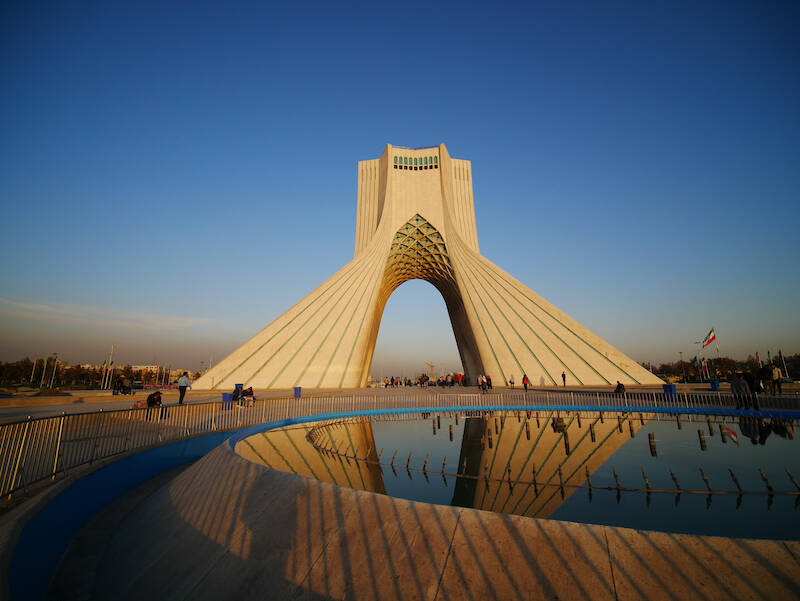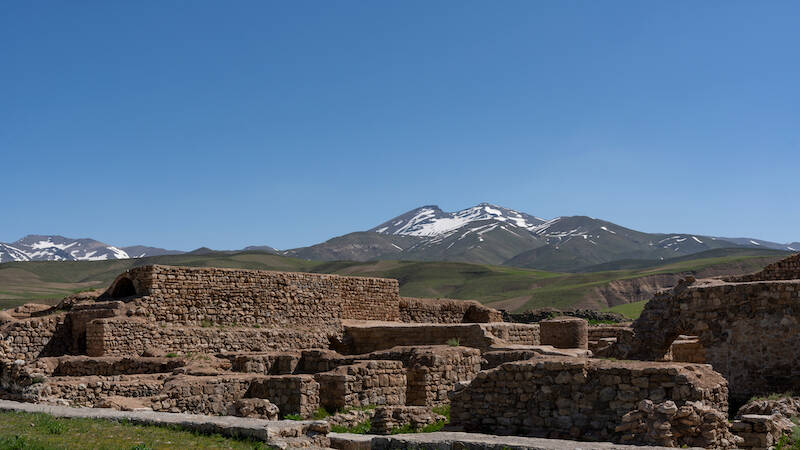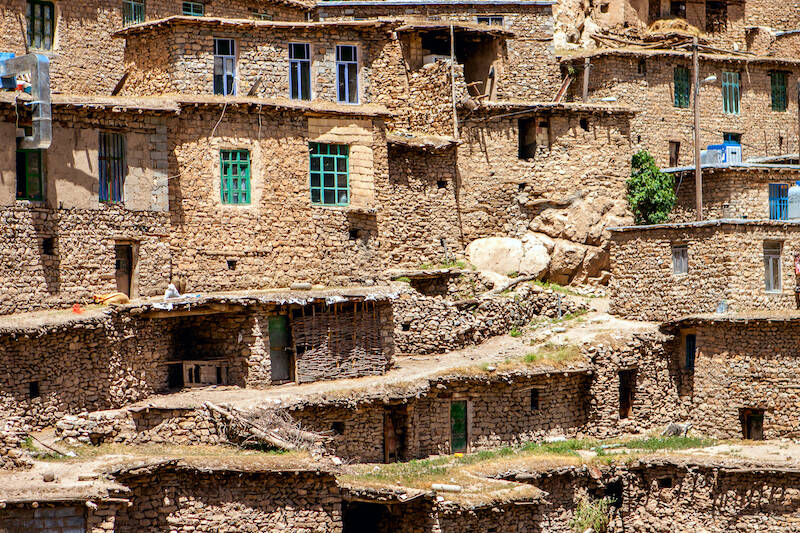Iran Discovery Tour :Tehran, Lahijan, Masuleh, Mt. Sabalan, Takht-e Soleyman, Sanandaj, Kermanshah, Khoramabad, Koohrang, Isfahan

Day 1 Arrival Tehran
You arrive in the capital of Iran and will be met on the airport by our representative, who will escort you to the hotel


Day 2 Tehran
The first day of your trip is a visit to the capital city, Tehran, the largest metropolitan city in the Middle East. Tehran never sleeps. This large city during the recent history of Iran was the home of very important events. To discover Tehran and its different lives and lifestyle one day is not enough. You will be amazed how tradition and modernity come together and make the structure of this city. There is plenty to do and see in Tehran. Depends on what you like to do, Tehran can offer you many of interesting museums, traditional and local bazaars, modern shopping centers, galleries of modern art, parks, mountains, ski resort in the season, historic buildings, modern architecture, street foods, hipster café , high-end classy restaurants … for a classic city tour in Tehran we may suggest you to have a visit of National Museum. This museum has two exhibitions, The Museum of Ancient Iran and the Museum of Islamic Art and Architecture. We may suggest that you to pay a visit to this museum in order to have a general idea of what you will visit on your next days of your travelling.
The other place which can be suggested is the Golestan Palace , which is one of the oldest historic places in the city and formerly was the royal Qajar complex. The complex of Golestan Palace consists of 17 structures, including palaces, museums, and halls. Golestan palace has a collection of Iranian crafts and European presents from the 18th and 19th centuries. If it fits your program do not miss Treasury of National Jewels and be fascinated by all the gemstones and the history behind each piece. The Grand Bazaar of Tehran is one of the places you should visit. Tehran Grand Bazaar splits into several corridors and each specializes in different types of goods. So far you are in the old part of Tehran, to get some idea about the modern part of the city you should drive to north of the city and spend some times in Nature Bridge (Pol-e Tabiat) and sit and relax in one of the many cafes and get refresh while you have a view of Tehran.
This list is a few places in Tehran that you can visit. You can always ask us for more detailed information.

Day 3 Tehran - Lahijan
After breakfast you leave the busy city and drive through the green valleys of the Alborz mountain range on your way to the Caspian Sea. This mountain road, Chalus Road, is one of the most beautiful in the country in terms of view. The coast along the Caspian Sea is one the greenest strips of the country, and therefore beloved by the Iranian population that mostly live in dry, desert regions. Visit the picturesque Lahijan, famous for its tea plantations. Here you can walk through the tea plantations in the hill of “Sheitan Kuh” and enjoy the view.

Day 4 Lahijan - Masuleh
The route along the Caspian Sea takes you to the port city of Bandar-e-Anzali and on to Masuleh, a charming mountain village. This village is always misty and you can walk over the roofs of the houses. It is like an elevated street! This village is at least a thousand years old and is one of the most beautiful villages in Iran. In the afternoon you can choose to take a walk around Masuleh. One interesting place (but it takes some time), is the fortress of Rudkan, hidden in lush forest.

Day 5 Masuleh - Meshkin Shehr
A long, but beautiful ride brings you into the province of Azerbaijan. You will pass the green mountains of Talesh, home of Talesh nomads and scattered mountain villages. Main city of Azerbaijan region is Ardabil. In the past, the city was an important Sufi center. The main attraction is the mausoleum of Sheikh Safi od-Din Ishaq, the ancestor of the Safavids.
The city is situated on the foot of Mt. Sabalan, the second highest mountain in Iran. You will come closer to the peaks of the mountain near the area of Meshkin Shehr where you will sleep, surrounded by great mountain views, nomads and herds of sheep and goats.
In the town of Meshkin Shehr you will find the largest hanging bridge in Iran, a popular attraction with local tourists.

Day 6 Meshkin Shehr
Today you have a choice of different options.
Mt. Sabalan is the home of the Shah Savan nomads, a Turkic speaking tribe who, from spring to autumn, put their tents on the foothills of the mountain. You can make a hike in the valleys and meet some of the nomads and see their lives.
You can also go to the Ghotorsoei hot springs. If you are interested to climb the Mt. Sabalan, from here you can rent a jeep to take you up to the base camp. Near a small mosque you will find many tents of people climbing the peak. Technically not difficult, this is one of the most popular climbs in Iran. You can hike some parts. If you really want to go all the way to the top you have to get up very early!!

Day 7 Meshkin Shehr - Takht-e Soleyman
A long day driving through endless, barren landscapes to one of Iran's most important historic sites; Takht-e Soleyman, also known as the Throne of Solomon. Here you will find the remains of an old fortress, once an important stronghold in times of Parths, Aechemenids and Sassanids. It is an important place for Zoroasters as well, with different ancient temples in the complex. The place is one of Iran's 24 Unesco Heritage Sites.
You will sleep in an eco-resort not far from this historic site.

Day 8 Takht-e Soleyman - Sanandaj
Next stop is the capital of the Iranian part of Kurdistan; Sanandaj. One of the most beautiful regions of Iran is the mountainous region of Kurdistan. The Kurds are easily recognizable with their baggy trousers and the colorful dresses of the women. The people are very hospitable towards foreign visitors. You find many beautiful mountain villages here.
You will sleep in Sanandaj; a bustling city where the main thing to visit is the bustling bazaar, full of Kurds and Iranians selling and buying all kinds of stuff. You can also visit the Asef mansion, dedicated to Kurdish culture and the regional museum.

Day 9 Sanandaj - Kermanshah via Palangan
You drive through Kurdistan and will visit the beautiful village of Palangan. Stapled houses on mountain slopes in a valley, with a small river, shaded fish restaurants and lots of sheep and goats. Definitely worth trying to eat the fresh trout here.
Next stop is Kermanshah, where we will do our best to accommodate you in an old caravanserai. Kermanshah is, like Sanandaj, a big and puzzling city and one of the main Kurdish cities.

Day 10 Kermanshah - Khoramabad via Bisotun and Taq-e Bustan
Near Kermanshah you find 2 of Iran's most outstanding examples of ancient art. The rock reliefs of Taq-e Bustan, dating from the Sassanid period around the 4th century. You will find reliefs of the kings Ardashir II and Shapur II.
More rock reliefs are to be seen at the site of Bisotun, located on the old trading route between Ecbatana and Babylon. Here you find the relief of king Darius from the Achaemenid empire.
You continue to the province of Lorestan, home to the Lurs, one of Iran's many nomadic tribes. You sleep in the capital city of Khoramabad where an ancient fortress dominates the town.

Day 11 Khoramabad - Chelgerd
A beautiful day will bring you to the Koohrang mountain range, home of the Bakhtiari nomads. This is one of the largest tribes in Iran. The men are easily recognisable with their black-and-white striped coats and black hats.
The small town of Chelgerd is one of Iran's ski-resorts but home also to the Bakhtiari. In the valleys around Chelgerd the Bakhtiari gather in summer months to herd their flocks of sheep and goats in the green mountain pastures. In winter they live in the warmer province of Khuzestan. One of the great sights in Iran is to see the movement of the nomads from winter to summer pastures. A journey that could take many weeks, but nowadays is mostly done by vehicles.
You sleep in a tented camp in a valley, surrounded by nomad tents.

Day 12 Chelgerd
A full day to enjoy nature. You can go hiking in the mountains. You might also be able to rent a horse and do some horse riding. Or drive a little up the valley where you can climb a glacier, or even further and visit remote mountain villages. The village Sar-e Agha Sayed is one of Iran's remotest and most beautiful mountain villages.
Everywhere you will see the black tents of the Bakhtiari nomads and you are able to learn more about their nomadic life.
In the evening enjoy a real Iranian classic; Bakhtiari kebab.


Day 13 Chelgerd - Isfahan
Today you will travel to the splendid city of Isfahan.
This city is famous for its Persian – Islamic architecture and one of the largest city squares, Naghsh-e Jahan square. Your city tour will start with visiting this famous and truly beautiful square, where you will find Sheikh Lotfollah Mosque on its eastern side, this mosque was built during Safavid dynasty, Shah Abbas I and was a private mosque for the royal court.
The next monument is Imam Mosque (formerly Shah Mosque) on the south side of the square also built under the order of Shah Abbas I considered as one of the masterpieces of Persian architecture. Next site, opposite Sheikh Lotfollah Mosque, is the imperial Palace of Ali Qapu, the best example of Safavid art and architecture. Now time for one of the oldest Bazaars in Isfahan, Qeysarie Bazaar in the north side of the square. The entrance of Bazaar is full of paintings and you will be amazed by the high ceiling and all the art details you find on the roof.
Among other places you can visit in the afternoon Chehel Sotoun is highly recommended, this Pavilion that was built under the order of Shah Abbas II is in the middle of a park and used for his entertainment.
In the evening you will enjoy the city on your own, having dinner in one of the many local restaurants that all of them serve high quality food and no matter where your hotel is located, you can always find some of these good places easily.

Day 14 Isfahan
You wake up again in Isfahan while your head is still full of those dreams you had last night of all the eslimi patterns, miniature, frescos… and still another day.
Isfahan is also famous for its Zayandehrood, the largest river of the Iranian Plateau. Anywhere is a river, there are some bridges and bridges in Isfahan are among the most beautiful ones. There are eleven historical bridges over Zayanzehrood. You will visit 2 of them. Allahverdikhan Bridge, popular as Si-o Se Pol is the largest one. The next bridge is Khaju Bridge, in the words of Arthur Pope and Jean Chardin, Khaju is "the culminating monument of Persian bridge architecture and one of the most interesting bridges extant ... where the whole has rhythm and dignity and combines in the happiest consistency, utility, beauty, and recreation.
Isfahan also has a great number of Armenian population. You will have a visit to Armenian Quarter in Jolfa district and will visit Vank Cathedral and its museum. While you are walking in the streets and alleys of Jolfa you can smell coffee, no wonder, you can find many coffee bars here and all serve nice coffee. Jolfa is also a very nice part of the city to spend your evening. Many young people will come for dinner here and you see a lot of street food and also good restaurants.
Day 15 depart
An escorted transfer based on your flight time will be arranged to the airport…. Have a safe flight.

